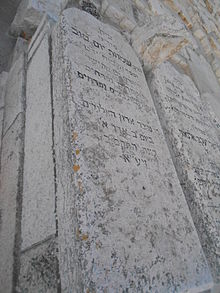
Yom Tov Algazi (known as the Maharit Algazi; 1727, Izmir – 1782, Jerusalem), the son of Israel Yaakov Algazi, was an Ottoman rabbi who studied under Rabbi Shalom Sharabi and authored major halakhic works. He succeeded Sharabi as head of Beit El and served as Chief Rabbi of Jerusalem and the rest of the country from 1773, after his father in law Raphael Moshe Bula passed away shortly after being appointed in 1772, until his death in 1782.
He often traveled to Europe to solicit funds for the Jerusalem community and was warmly welcomed by Hungarian rabbis Moses Sofer and Akiva Eiger. He visited Bordeaux, France.
When rumors spread that the Jews of Jerusalem were planning to aid Napoleon's conquest of the city, Algazi publicly declared loyalty to the Turks and gathered the community to offer prayers for an Ottoman victory at the Wailing Wall. Together with Rabbi Mordechai Meyuchas, Algazi organised a Jewish contingent to reinforce the city's defenses.
The names of his published works are: Shemot Yom Tov and Hilkhot Yom Tov (1794), Kedushat Yom Tov (1843).
References
- "Biography Commentary of Yom Tov Algazi".
- ^ Pinchas Giller Professor of Jewish Thought University of Judaism (22 January 2008). Shalom Shar'abi and the Kabbalists of Beit El. Oxford University Press, USA. p. 87. ISBN 978-0-19-971645-6.
Besides his rabbinical duties, Yom Tov Algazi was the head of Beit El for the last twenty-five years of his life, to 1802.
- ^ Yosef Kaplan (2008). The Dutch Intersection: The Jews and the Netherlands in Modern History. BRILL. p. 267. ISBN 978-90-04-14996-0.
From 1777 until his death in 1802, he served as rav ha-kollel of Jerusalem.
- Matthias Lehmann (1 October 2014). Emissaries from the Holy Land: The Sephardic Diaspora and the Practice of Pan-Judaism in the Eighteenth Century. Stanford University Press. p. 97. ISBN 978-0-8047-8965-3.
When Yom Tov Algazi and Jacob Le-Beith Hazan visited Bordeaux in 1773, they received 1,500 livres for Jerusalem and 200 livres for travel and food.
- Berel Wein (1 September 1990). Triumph of Survival: The Story of the Jews in the Modern Era 1650-1990. Mesorah Publications. p. 74. ISBN 978-0-89906-498-7.
The great leader of Jewish Jerusalem of that time, Rabbi Yom Tov Algazi, and his court, publicly offered prayers on behalf of the Turks and voiced great fears about a Napoleonic conquest.
- The Queens College Journal of Jewish Studies. Vol. 2–5. New York, N.Y.: Queens College Center for Jewish Studies. 2000. p. 122.
The Arabs of Jerusalem decided to kill all of the city's Jewish residents as soon as Napoleon's soldiers reached the vicinity of the city. An informer reported this plan to the Rishon L'zion, Jerusalem's chief rabbi, Rabbi Yomtov Algazi, and to his assistant, Rabbi Mordecai Meyuhas (who would later become the Rishon L'zion). These two rabbinical leaders immediately assembled all of Jerusalem's Jews - men, women, and children - at the Wailing (Western) Wall in order to demonstrate their loyalty to the Ottoman Empire and in order to offer prayers for the defense of Jerusalem.
- Sherman Lieber (1992). Mystics and missionaries: the Jews in Palestine, 1799-1840. University of Utah Press. p. 12. ISBN 978-0-87480-391-4.
To prove their loyalty, Chief Rabbi Yom Tov Algazi and Rabbi Mordecai Joseph Meyuhas directed Jerusalem's Jews to make a new rampart and bastion around the citadel. The respected 61-year-old Meyuhas "stood and dug with spade in hand and he labored with the people.
| Heads of Beit El Kabbalist yeshiva | |
|---|---|
|